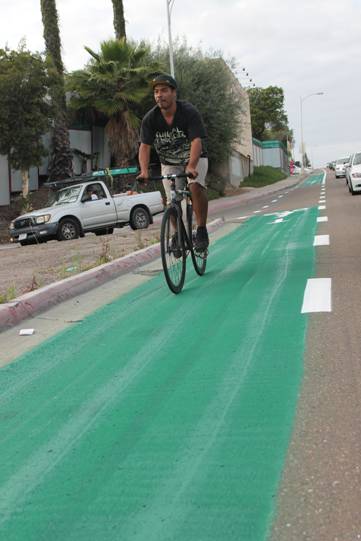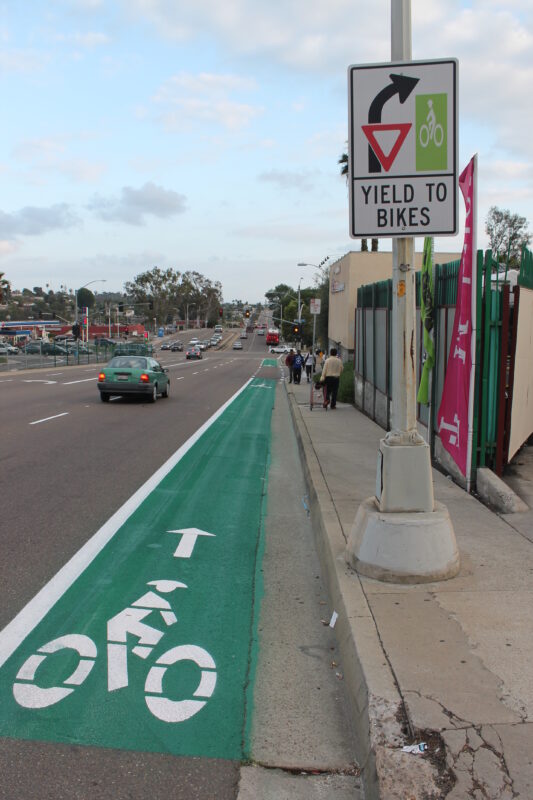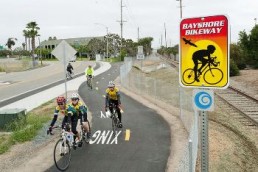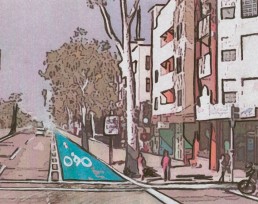$312 million updated Bike Plan passes with unanimous support from City Council

Last Monday, the update to the 2002 Bicycle Master Plan passed with unanimous support from the City Council. This plan to build an additional 595 miles of bicycle facilities nearly doubles the city's existing 510 miles* of facilities and further demonstrated our council's growing commitment to bicycling.
During public comment, two of our proposed requests were included in the motion made by Council Member (and current mayoral candidate) David Alvarez and amended by Council Member Sherri Lightner. Our request to create a Bicycle Advisory Committee to ensure the implementation of the plan was also supported by the San Diego County Bicycle Coalition (SDCBC). Our request to remove the Coastal Rail Trail alignments from Rose and Roselle Canyons was not supported by the SDCBC but was supported by the community that this alignment affected: the Friends of Rose Canyon, the University Community Planning Group and Council Member Lightner whose district includes University City. Council Member Lightner spoke to not only preserving the city's limited remaining open space but to also saving the city the huge financial and environmental expenses of building in Rose and Roselle Canyons - an amendment that was accepted by Alvarez and the rest of the council.

Melissa Garcia, Senior Planner at the City of San Diego, presented the item for council consideration by stating that the goal of the plan was to "create a city where bicycling is a choice." The goal to promote "environmental quality, public health and recreation and mobility benefits" were also mentioned. The purpose of the plan, Garcia stated, was to "maximize spending choices for implementation."
The original Bicycle Master Plan was adopted by the City Council over a decade ago in 2002. The update to the 2002 Bicycle Master Plan was prepared by Alta Planning + Design for the City of San Diego and begins with this promising statement in its introduction:
"...the updated plan provides direction for expanding the existing bikeway network, connecting gaps, addressing constrained areas, improving intersections, providing for greater local and regional connectivity, and encouraging more residents to bicycle more often."
Since 2002, most of the facilities built have been incredible and award-winning (such as the bike path around Lake Murray and Miramar Reservoir), but not effective in meeting the needs of everyday San Diegans by connecting neighborhoods to ensure daily riding in a way that is safe and comfortable. In the two years since the plan was updated, the plan went through respectable community feedback and input. Is the plan the best that it can be for current and future riders? The plan is incredibly promising and it should give everyone cause to celebrate. But a good plan alone will not transform our city. The important lesson from the last Monday's vote is that the political will is unanimous and the way forward is to ensure that this plan actually gets implemented with the efforts of a Bicycle Advisory Committee.

What will this committee do and who will it be composed of? That depends on what the City Attorney proposes to the City Council, but we'd like to have council staff, city staff, advocates and community members (including high school and college students) be active representatives. This committee will ensure that facilities get built and that the group doesn't become yet another layer of bureaucracy inhibiting the implementation of the bicycle plan. We'd like to see all facilities implemented with complete transparency.
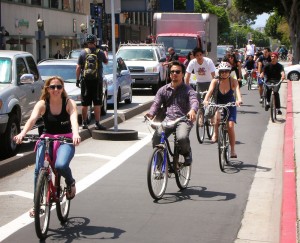
In this year alone, our council members have demonstrated incredible leadership. Interim Mayor Todd Gloria was the first to lead on the issue. Gloria has been very receptive to feedback, ideas, and has demonstrated a willingness to lead in a way that has not been seen before in San Diego. Council member and Land Use and Housing Chair Lorie Zapf's Council Resolution has provided us with much needed leverage to ensure accountability from the city staff in implementing bicycle infrastructure in the city. We have also learned how to listen to communities (such as the Friends of Rose Canyon) that seek us out and explain their concerns. Our success in transforming this city into a world-class city for bicycling depends on meeting the needs of our current ridership and being open and receptive to the feedback we receive from potential riders.
The next steps are not only to create the Bicycle Advisory Committee, but also to ensure that the plan is implemented. How will that happen? That will be the work for BikeSD's second year. Thank you for joining us on the ride.

---
Update on Year 1 Goals: Increasing City Funding for Bikes
When we launched last year, our board voted on a list of seven goals to help guide our advocacy efforts during our first year. We met many of our goals and are working towards or fine-tuning the remainder. We will provide a full update on how our first year transpired along with our annual report. Until then, I want to provide an update on our Goal #5:
Work to increase city funding for bikes from 0.1% of General Fund to 0.9% of General Fund to reflect existing bike mode share. Bike infrastructure, especially good quality bike infrastructure costs money and we’re going to advocate to increase funding in the City’s budget.
First, the good news: in this year's adopted budget, 3% of the city’s transportation budget will be spent on bikes.
Second, we need to dig deeper and learn more about what we uncovered.

Our board approved this goal last year based on the concept of induced demand. Induced demand also applies to bicycle facilities and within bike advocacy circles this translates into "build it and they will come".
In retrospect, the original goal as listed was a bit imprecise; for example, there was no need to base the amount off of the General Fund instead of the Transportation Department’s budget. However, this gave us an opportunity to learn about the complexity of bicycle facility funding.
In 2011, 0.9% of San Diegans (now 1.1%) were commuting by bicycle. We wanted to see a matching percentage of dedicated funding devoted to bicycle facilities and for that percentage to grow to facilitate bicycle ridership in the city.
We can see this correlation in other cities that have prioritized bicycling as a mode of transportation.
A more useful metric is per capita spending on bicycle facilities. We've been working towards the goal of $39 per capita to meet the Danish and Dutch funding reality. These two nations have figured out how to move nearly 50% of their population by bicycle in their largest cities.
What is being spent in San Diego?
In the city of San Diego a single bicycle facility can be built with funding from the city, the region (SANDAG), the state and/or the federal government. Tracking these numbers down has been a painful process, so we decided to start with the city.
Where does a tiny little organization even start? We started by making strategic alliances. In this case, I'm proud to state that we joined forces with the Center on Policy Initiatives (CPI) who created the Community Budget Alliance (CBA) - an alliance of over 40 organizations formed two years ago to advocate for a fair, equitable and transparent budget. When the former mayor released his draft budget earlier this year to the public for input, we worked with the CBA to dissect the budget.
Bicycle facilities can be both capital improvement projects (like the Mike Gotch bicycle/pedestrian bridge) or service-related projects (such as sharrows, bike route signs or the new buffered bike lanes being striped alongside the ongoing resurfacing efforts).
It's almost overwhelming to envision the facilities that need to be built in order to become a world-class bicycling city. However, in the last year we have focused on some of the deficiencies in the city, such as the deadly freeway on-ramps and off-ramps that are found in nearly every community. Freeway on-ramp redesigns would fall under the realm of a capital improvement project and since these facilities fall under the jurisdiction of two or more agencies (in this case, the city of San Diego and Caltrans), agency coordination is absolutely critical.
Through the training led by the CPI, we learned about the two categories of bicycle facilities: capital projects and service projects. But how much was the city spending on them? In April this year, I asked Corrine Wilson at CPI, who put me in touch with Nelson Hernandez, the city's Assistant Chief Operating Officer. I posed this question to him:
I was asked to contact you about getting some detail from the mayor's proposed budget. Since bicycle infrastructure comes under the umbrella of both capital improvement projects (assets) as well as service related projects - I find it an incredible challenge to break down what actually is being allocated toward bike projects in the city budget. Is there a way for you to send me that information and perhaps make it easier to find within the budget documents?
Hernandez directed me to the city’s Deputy Director of Transportation, Linda Marabian, who responded:
Sam, what I am familiar with and am working on is the CIP annual allocation projects I discussed at our last meeting regarding this issue. That is identified in the CIP Section of the budget.
This year’s budget lists both Capital Improvement Plans (CIPs) and service-related projects (including some staff funding) for a total of $1.109 million. This is a per capita spending of $1.17 or 3% of the total Transportation Department's budget. The projects listed in the budget were as follows:
- Minor bike facilities, $639,000: this includes sharrows, signs, bike lanes, and facilities that can be built based on traffic service requests.
- State Route 163/Clairemont Mesa Blvd Interchange, $350,000: The budget detail states that "[t]hese improvements will eliminate existing pedestrian/bike high-speed crossings and all vehicle, bike and pedestrian moves will be controlled, thus improving safety. Transit movement through the interchange will be area will be greatly enhanced."
- Bicycle Program Manager, $120,744: This position was held by Ed Clancy, but according to Marabian this position was "reabsorbed" into the department after Clancy's resignation. This council-approved position has been vacant for months and, despite our letter to Interim Mayor Gloria, has not been filled. We are at-risk of losing our hard-fought momentum.
With the elimination of Clancy's position, the city is spending $989,000 on bikes.
City funds are not the only funds that are used to build bicycle facilities. SANDAG also provides funds via Transnet. How much was SANDAG allocating to the city of San Diego?
While browsing the Independent Taxpayer Oversight Committee report on Transnet expenditures, I found that the city seemed to be sitting on about $54 million. Could these funds be spent on bicycle facilities? I asked Marabian how the city determined its Transnet spending priorities and she responded that Council Policy 800-14 determines the prioritization factor.
Understanding Council Policy 800-14
The CBA, as led by the talented individuals at CPI, has been working with councilmembers and city staff on updating Council Policy 800-14. The purpose of the policy (which was adopted by the council last night) is:
to guide the Mayor’s Capital Improvement Program Review and Advisory Committee (CIPRAC) in its CIP deliberations. The goal of this policy is to establish a capital-planning process that ultimately leads to policy decisions that optimize the use of available resources for projects competing from the same fund source or multiple fund sources.
When the draft policy was scheduled to be released at the council infrastructure subcommittee last month, we worked closely with CBA and city and council staff to ensure that our needs were addressed in the policy. The draft language on prioritization was excellent and had a few gems, including the following:
scoring projects higher that result in:
reduction in accidents, main breaks, sewer spills and flooding problems.promote community walk-ability and use of bicycles or public transit.
Our input had two main points: account for the fact that some assets can have multiple owners (such as the on-ramps mentioned above), and recognize that the biggest return on investment (especially for bicycle facilities) would be had in areas of high population density like the urban core communities in Mid-City.

Last night, our city council unanimously approved the policy (with Council President Gloria absent). Although we joined in at the tail end of updating this policy document we're glad to have been a part of this historic moment. The newly-strengthened council policy will ensure that our second year of advocacy will be more deliberate and informed by policies to strengthen our advocacy efforts.
Thank you to all our members who showed up in support!
Tomorrow: Fight to support GREAT cycling facilities in North Park/Mid-City

Tomorrow marks the third installment in SANDAG’s series of North Park - Mid-City Regional Bike Corridor Project Community Advisory Group meetings. According to Bridget Enderle, Associate Active Transportation Planner at SANDAG “The focus of this third meeting will be to review the alignment study results and to discuss the benefits, challenges, and other considerations related to each of the alignment options.” During the past meetings, three main corridors were presented as options: Meade Ave, Howard Ave/Orange Ave and Landis St/Wightman St.
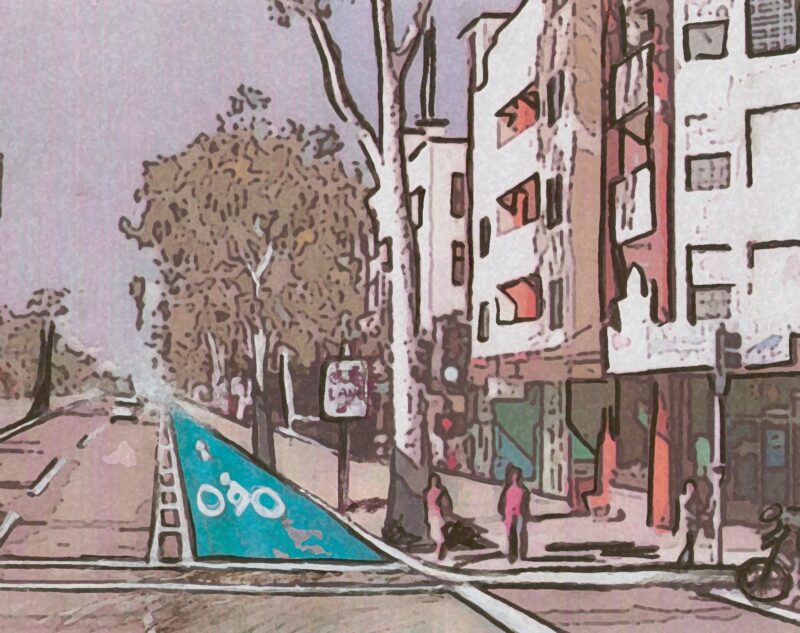
As we have reported previously, cycle tracks on El Cajon Blvd have not appeared to be of much interest to SANDAG officials involved in the project, regardless of the overwhelming vocal support they have garnered at the meetings. The main discussion by project leaders has revolved around neighborhood greenways that push bikes off to the side streets. One of the main project goals claims to be “to provide DIRECT ACCESS to schools, transit, community destinations, and commercial centers”. With this stated goal, it would make sense to provide cycling facilities along a major corridor with actual destinations, rather than directing bikes through residential areas.
Here at BikeSD we are pushing for “great” facilities, not just “good enough”. If you love cycling and want to see San Diego progress as a world class cycling city, come out tomorrow and let your voice be heard. Help us fight to transform San Diego into the world’s best city for bicycling!
The meeting starts tomorrow at 6:00:
Tuesday, June 25, 2013 - 6:00 - 8:30 pm
at the
Teen Challenge Center
5450 Lea St, San Diego, CA 92105
Foto Friday: Enhanced Bike Lanes on (a part of) Montezuma Road
Montezuma Road stands as something of a poster child for failure: it is a city road linking the thick populations and work centers of College Area, Rolando, parts of City Heights, La Mesa and beyond with Mission Valley and points west and north. Yet, it has wide lanes, high speeds, and a general layout that seems to forget that fleshy humans inhabit the city and that pedestrians and bicycle riders might also use this important route.
This morning, on Bike to Work Day, we learned that the eastbound (from Fairmount Avenue to Collwood Boulevard) side got the Genovese Treatment.
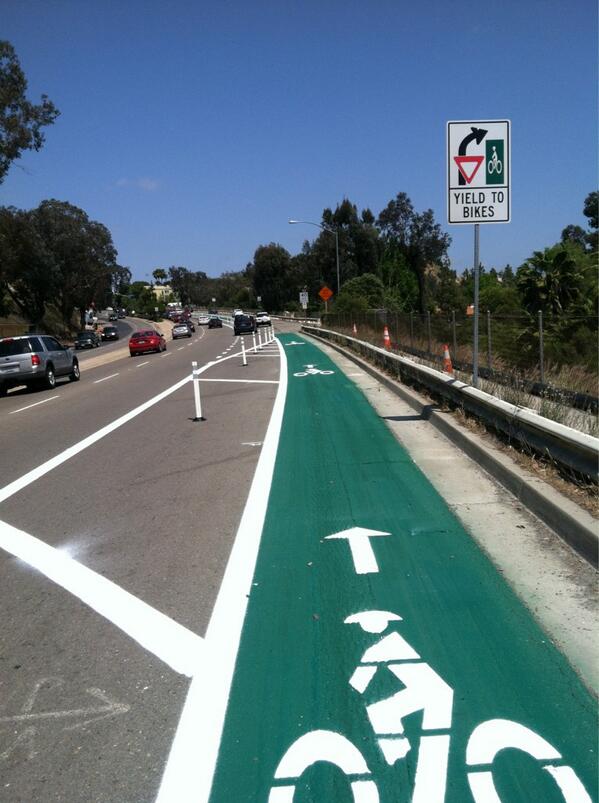
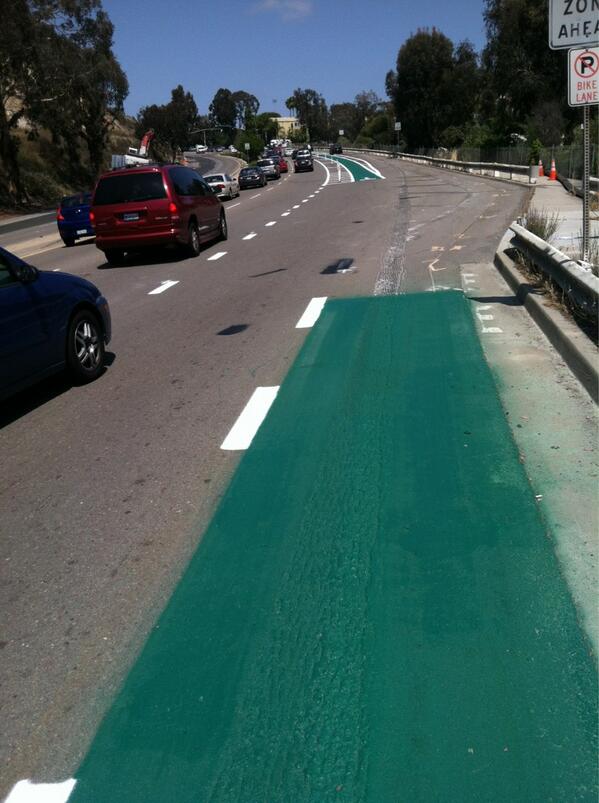
Brian Genovese, Head of the City’s New Multi-Modal Section, leads a novel effort: to use state-approved design guidelines and the city’s resurfacing & slurry seal program to create buffered, visible, and much safer and more facilitative Class II bicycle lanes with little more than paint, political will, know-how, and changing the way traffic engineers think.
These projects are “low hanging fruit” because they are already approved at a state level and resurfacing projects already require new paint. But instead of relegating bicycle riders to an afterthought, the city has begun to understand that many of our roads create hazardous conditions for riders – and for people who would like to ride.
People in San Diego who want a city designed at a human scale should congratulate and encourage Genovese and his leadership. You may email him at BGenovese@sandiego.gov. You should also thank the mayor who is making sure stuff is happening and moving quickly: bobFilner@sandiego.gov
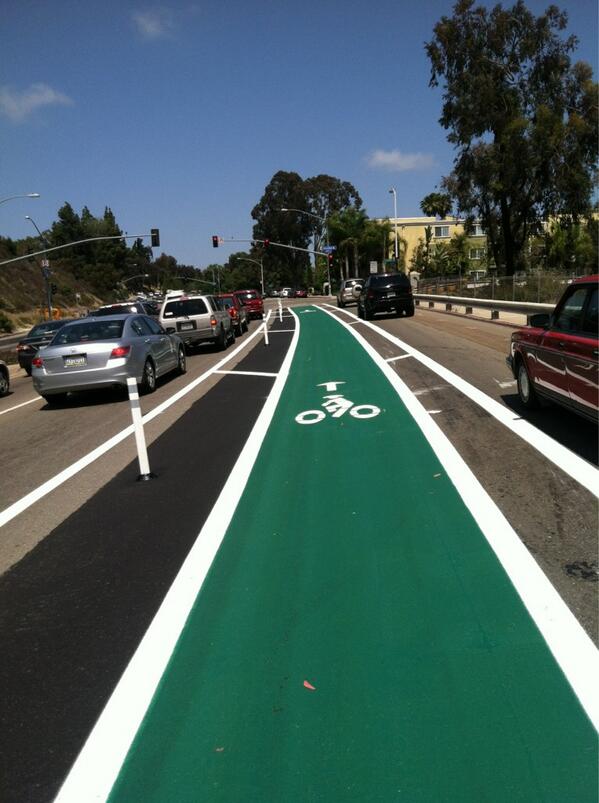
New Green Bike Lanes in City Heights
The Active Transportation Manager at the City Heights Community Development Corporation (CDC), Randy Van Vleck, sent out an email yesterday stating that the bike lanes on 54th Street had been upgraded with green paint.
The standard bike lane was upgraded with green treatments to alert bicyclists and motorists of the conflict point on the north-west corner of the 54th St & Uni Ave intersection. The treatment also includes bike lane dashes in the conflict point and a “Yield To Bikes” sign with an image of a green bike lane; the first of its kind in San Diego.
The green bike lane was installed by the City last week in response to City Heights CDC’s request on behalf of the City Heights Built Environment Team (BET); a group of residents advocating for a health-supportive built environment. Residents and BET members have been raising the profile on the need for improved safety at this intersection for 2 ½ years. We’d like to thank the following folks for the great work they’ve done to make this intersection a priority:
-City Heights Built Environment Team
-Residents of the 54th St & Uni Ave area
-Mayor Filner and Bike Program Initiatives Manager Ed Clancy
-Councilmember Emerald and staff
-Traffic engineers Brian Genovese, Tom Landre, Linda Marabian, and Esmerelda White
-Bike SD Executive Director Samantha Ollinger
-Vien Dong market
-Environmental Health Coalition, International Rescue Committee, Academia de Comunitario Liderazgo, Star Pal, Colina Park Neighborhood’s First Initiative
-City Heights Area Planning Committee
-University Avenue Mobility Plan (54th St to 68th St) Working Group
-Media coverage: Megan Burks (Speak City Heights), Brian Myers (Media Arts Center), Adrian Florido (then with Voice of San Diego, now with KPBS), NBCThere’s still a lot more work to do at this intersection to make it safe for all people, especially pedestrians, and for it to reflect the principles of the California Complete Streets Act and new California Highway Design Manual. We see the green bike lane as a symbol of a commitment to not only improve safety for active transportation at this intersection but to encourage it.
Come see the green bike lane for yourself this Friday, May 17 at the City Heights CDC Bike To Work Day Pit Stop! We’ll be on the north-west corner island of 54th St & Uni Ave from 6am to 10am with shade, free refreshments, snacks, and giveaways for bike commuters. Hope to see you then!
